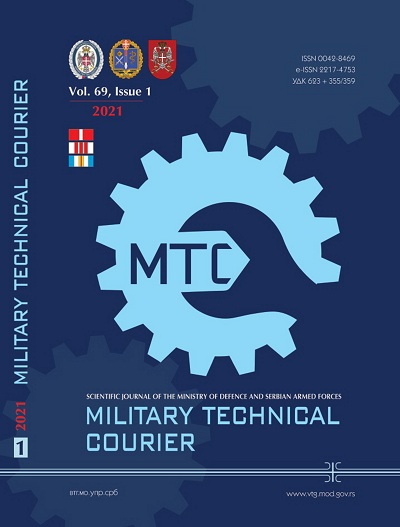Safety in residential buildings - evacuation from residential buildings without fire escape stairs
Abstract
Introduction/purpose: Safety in high residential buildings presents a very important and always actual task. In case of some unforeseen and dangerous occurrences, their residents must be evacuated. Fire, earthquakes, and terrorism are only some of such situations. The speed of evacuation from high residential buildings depends on many different factors. A particularly difficult and complex evacuation task concerns buildings without fire escape stairs.
Methods: The modeling method was used in this paper. Based on a real object – a residential building, an appropriate simulation model was realized in appropriate simulation software.
Results: The results of this paper have shown that, out of four scenarios, the fastest evacuation was for the evacuation speed of 1.75 m/s. The first two scenarios did not report any jams, unlike the third and fourth scenario; in the third scenario, the occupants' speeds were 0.75 m/s and 1.25 m/s while in the fourth scenario, the simulated occupants' speeds were from 0.75 m/s to 1.75 m/s.
Conclusion:The usage of appropriate simulation software enables fast, precise, safe and cheаp calculation of evacuation times and it can significantly improve evacuation procedures and evacuation strategies.
References
Ding, N., Chen, T. & Zhang, H. 2017. Simulation of high-rise building evacuation considering fatigue factor based on cellular automata: A case study in China. Building Simulation, 10(3), pp.407-418. Available at: https://doi.org/10.1007/s12273-016-0337-9.
-Fos Media. 2018. Požar ogromnih razmjera u centru Sao Paula, ima žrtava. Fos Media, 1 May [online]. Available at: https://fosmedia.me/svijet/globus/u-centru-sao-paula-gore-zgrade-ima-zrtava-foto (in Serbian) [Accessed: 21 August 2020].
Gershon, R.R.M., Magda, L.A., Riley, H.E.M. & Sherman, M.F. 2011. The World Trade Center evacuation study: Factors associated with initiation and length of time for evacuation. Fire and materials, 36(5-6), pp.481-500. Available at: https://doi.org/10.1002/fam.1080.
Glavinić, P. & Rašković Đ. 2016. Priručnik za pripremu kandidata za polaganje stručnog ispita iz oblasti zaštite od požara. Belgrade: Meritus tim (in Serbian). ISBN: 978-86-917589-91.
Hartley-Parkinson, R. 2019. Grenfell Tower fire report finds far more people could have survived disaster. Metro, 29 October [online]. Available at: https://metro.co.uk/2019/10/29/london-fire-brigade-serious-shortcomings-response-grenfell-disaster-11001429/ [Accessed: 21 August 2020].
Jevtić, R.B. 2016. Simulation of evacuation situations in order to protect human lives and material property. NBP. Nauka, bezbednost, policija, 21(2), pp.35-48. Available at: https://doi.org/10.5937/nbp1602035J.
Jevtić, R.B. 2018. Fire and evacuation in high residential buildings. Facta Universitatis, Series: Working and living environmental protection, 15(2), pp.123-134. Available at: https://doi.org/10.22190/FUWLEP1802123J.
Jevtić, R.B. 2019a. Simulation of fire as a form of safety and protection of human lives and material assets. Facta Universitatis, Series: Working and living environmental protection, 16(3), pp.171-184. Available at: https://doi.org/10.22190/FUWLEP1903171J.
Jevtić, R.B. 2019b. Sanitary objects evacuation with presence of immobile occupants. Zdravstvena zaštita, 48(1), pp.61-68. Available at: https://doi.org/10.5937/ZZ1901061J.
Kady, R.A. & Davis, J. 2009. The effect of occupant characteristics on crawling speed in evacuation. Fire Safety Journal, 44(4), pp.451-457. Available at: https://doi.org/10.1016/j.firesaf.2008.09.010.
Kasereka, S., Kasoro, N., Kyamakya, K., Doungmo Goufo, E-F., Chokki, A.P. & Yengo, M.V. 2018. Agent-Based Modelling and Simulation for evacuation of people from a building in case of fire. Procedia Computer Science, 130, pp.10-17. Available at: https://doi.org/10.1016/j.procs.2018.04.006.
Kinateder, M.T., Omori, H. & Kuligowski, E.D. 2014. The Use of Elevators for Evacuation in Fire Emergencies in International Buildings. Gaithersburg, Maryland: National Institute of Standards and Technology. Available at: https://doi.org/10.6028/NIST.TN.1825.
Mumović, N. 2019. Evakuacija iz stambenih objekata u vanrednim situacijama izazvanim požarima. MA thesis. Belgrade: University of Belgrade - Faculty of Security Studies (in Serbian).
Pauls, J.L. 2005. Evacuation of Large High-Rise Buildings: Reassessing Procedures and Exit Stairway Requirements in Codes and Standards. In: Proceedings of the 7th Conference of the Council of Tall Buildings and Urban Habitat, New York, USA, pp.16-19.
Poon, L.S. 1994. EvacSim: A Simulation Model of Occupants with Behavioural Attributes in Emergency Evacuation of High-Rise Building Fires. In: Kashiwagi, T. (Ed.) Fire Safety Science-Proceedings of the Fourth International Symposium, Ottawa, Ontario, Canada, pp.681-692, July 13-17 [online]. Available at: https://iafss.org/publications/fss/4/view [Accessed: 21 August 2020].
Ronchi, E. & Nilsson, D. 2013. Fire evacuation in high-rise buildings: a review of human behaviour and modelling research. Fire Science Reviews, 2(art.number:7). Available at: https://doi.org/10.1186/2193-0414-2-7.
Rozo, K.R., Arellana, J., Santander-Mercado, A. & Jubiz-Diaz, M. 2019. Modelling building emergency evacuation plans considering the dynamic behaviour of pedestrians using agent-based simulation. Safety Science, 113, pp.276-284. Available at: https://doi.org/10.1016/j.ssci.2018.11.028.
-Thunderhead. 2014. Pathfinder User Manual. Manhattan, KS, USA: Thunderhead Engineering [online]. Available at: https://www.thunderheadeng.com/wp-content/uploads/downloads/2014/10/users_guide.pdf [Accessed: 21 August 2020]
Xing, Z. & Tang, Y. 2012. Simulation of Fire and Evacuation in High-Rise Building. Procedia Engineering, 45, pp.705-709. Available at: https://doi.org/10.1016/j.proeng.2012.08.227.
Proposed Creative Commons Copyright Notices
Proposed Policy for Military Technical Courier (Journals That Offer Open Access)
Authors who publish with this journal agree to the following terms:
Authors retain copyright and grant the journal right of first publication with the work simultaneously licensed under a Creative Commons Attribution License that allows others to share the work with an acknowledgement of the work's authorship and initial publication in this journal.
- Authors are able to enter into separate, additional contractual arrangements for the non-exclusive distribution of the journal's published version of the work (e.g., post it to an institutional repository or publish it in a book), with an acknowledgement of its initial publication in this journal.
- Authors are permitted and encouraged to post their work online (e.g., in institutional repositories or on their website) prior to and during the submission process, as it can lead to productive exchanges, as well as earlier and greater citation of published work (See The Effect of Open Access).

